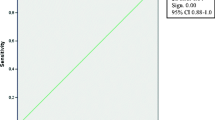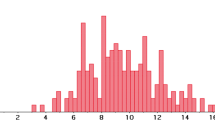Abstract
Patients who survive the acute phase of postdiarrheal hemolytic uremic syndrome (D+ HUS) may develop renal complications after years of apparent recovery. The optimal regimen for monitoring these children is unclear. We therefore determined if screening for microalbuminuria, in the absence of overt proteinuria at follow-up, increased the sensitivity for predicting long-term renal-related sequelae. We found that screening for microalbuminurea, within the first 6–18 months following an episode of HUS, increased the sensitivity for predicting later sequelae from 22 to 66.7%, compared to screening for overt proteinuria alone. These findings, if confirmed by a larger cohort with more years of follow-up, may facilitate early initiation of intervention strategies designed to reduce progressive renal damage.
Similar content being viewed by others
References
Siegler RL (1995) The hemolytic uremic syndrome. Pediatr Clin North Am 42:1505–1529
Siegler RL, Milligan MK, Burningham TH, Christofferson RD, Chang SY, Jorde LB (1991) Long-term outcome and prognostic indicators in the hemolytic-uremic syndrome. J Pediatr 118:195–200
Gagnadoux MF, Habib R, Gubler MC, Bacri JL, Broyer M (1996) Long-term (15–25 years) outcome of childhood hemolytic-uremic syndrome. Clin Nephrol 46:39–41
Milford DV, White RH, Taylor CM (1991) Prognostic significance of proteinuria 1 year after onset of diarrhea-associated hemolytic-uremic syndrome. J Pediatr 118:191–194
Perelstein EM, Grunfield BG, Simsolo RB, Gimenez MI, Gianantonio CA (1990) Renal functional reserve compared in hemolytic uremic syndrome and single kidney. Arch Dis Child 65:728–731
Hostetter TH, Olson JL, Rennke HG, Venkatachalam MA, Brenner BM (1981) Hyperfiltration in remnant nephrons: a potentially adverse response to renal ablation. Am J Physiol 241:F85–F93
Lewis JB (1998) Microalbuminuria: Accuracy of economics. Am J Kidney Dis 32:524–528
Panayiotou BN (1994) Microalbuminuria: pathogenesis, prognosis and management. J Int Med Res 22:181–201
Bakris GL (1996) Microalbuminuria: prognostic implications. Curr Opin Nephrol Hypertens 5:219–223
Hilgers KF, Dotsch J, Rascher W, Mann JF (2004) Treatment strategies in patients with chronic renal disease: ACE inhibitors, angiotensin receptor antagonists, or both? Pediatr Nephrol 19:956–961
Van Dyck M, Proesmans W, Depraetere M (1988) Hemolytic uremic syndrome in childhood: renal function 10 years later. Clin Nephrol 29:109–112
Fitzpatrick MM, Shah V, Trompeter RS, Dillon MJ, Barratt TM (1991) Long term renal outcome of childhood haemolytic uraemic syndrome. BMJ 303:489–492
Spizzirri FD, Rahman RC, Bibiloni N, Ruscasso JD, Amoreo OR (1997) Childhood hemolytic uremic syndrome in Argentina: long-term follow-up and prognostic features. Pediatr Nephrol 11:156–160
Garg AX, Suri RS, Barrowman N, Rehman F, Matsell D, Rosas-Arellano MP, Salvadori M, Haynes RB, Clark WF (2003) Long-term renal prognosis of diarrhea-associated hemolytic uremic syndrome: a systematic review, meta-analysis, and meta-regression. JAMA 290:1360–1370
Gianantonio CA, Vitacco M, Mendilaharzu F, Gallo GE, Sojo ET (1973) The hemolytic-uremic syndrome. Nephron 11:174–192
United Network for Organ Sharing. Addition to Kidney Transplant Waiting List by Diagnosis. United Network for Organ Sharing [electronic database]. Dec 2004. Available at https://doi.org/www.optn.org/latestdata/step2.asp. Accessed 26 Feb 2005
Loirat C, Sonsino E, Varga Moreno A, Pillion G, Mercier JC, Beaufils F, Mathieu H (1984) Hemolytic-uremic syndrome: an analysis of the natural history and prognostic features. Acta Paediatr Scand 73:505–514
Yap C, Yap HK, Chio LF (1991) Urine microalbumin/creatinine ratios in Singapore children. J Singapore Paediatr Soc 33:101–106
Elises JS, Griffiths PD, Hocking MD, Taylor CM, White RH (1988) Simplified quantification of urinary protein excretion in children. Clin Nephrol 30:225–229
Nathan DM, Rosenbaum C, Protasowicki VD (1987) Single-void urine samples can be used to estimate quantitative microalbuminuria. Diabetes Care 10:414–418
Gibb DM, Shah V, Preece M, Barratt TM (1989) Variability of urine albumin excretion in normal and diabetic children. Pediatr Nephrol 3:414–419
Huseman D, Gellermann J, Vollmer I, Ohde I, Devaux S, Ehrich JH, Filler G (1999) Long-term prognosis of hemolytic uremic syndrome and effective renal plasma flow. Pediatr Nephrol 13:672–677
Loirat C (2001) Post-diarrhea hemolytic-uremic syndrome: clinical aspects. Arch Pediatr 8 Suppl 4:776s–784s
Zurowska A, Gockowska Z, Czarniak P, Marczak E (2000) Changing clinical course of hemolytic uremic syndrome in children. Pol Merkuriusz Lek 8:234–235
Mencia Bartolome S, Martinez de Azagra A, de Vicente Aymat A, Monleon Luque M, Casado Flores J (1999) Uremic hemolytic syndrome. Analysis of 43 cases. An Esp Pediatr 50:467–470
Kelles A, Van Dyck M, Proesmans W (1994) Childhood haemolytic uraemic syndrome: long-term outcome and prognostic features. Eur J Pediatr 153:38–42
Acknowledgement
We gratefully acknowledge the advice and assistance of Andrew Pavia, M.D.
Author information
Authors and Affiliations
Corresponding author
Additional information
Dr. Randall M. Lou was a recipient of an International Society of Nephrology Fellowship Training Award.
This Research was partially funded by the Lois Joy Galler Foundation for the Hemolytic Uremic Syndrome.
Rights and permissions
About this article
Cite this article
Lou-Meda, R., Oakes, R.S., Gilstrap, J.N. et al. Prognostic significance of microalbuminuria in postdiarrheal hemolytic uremic syndrome. Pediatr Nephrol 22, 117–120 (2007). https://doi.org/10.1007/s00467-006-0283-3
Received:
Revised:
Accepted:
Published:
Issue Date:
DOI: https://doi.org/10.1007/s00467-006-0283-3




